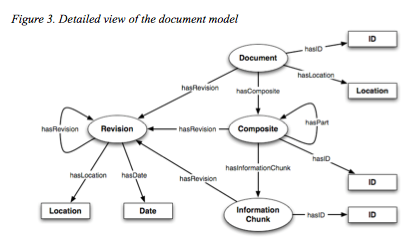An abstract framework for modeling argumentation in virtual communities
Citation: Tudor Groza, Siegfried Handschuh, John G. Breslin, Stefan Decker (2009) An abstract framework for modeling argumentation in virtual communities. International Journal of Virtual Communities and Social Networking (RSS)
Internet Archive Scholar (search for fulltext): An abstract framework for modeling argumentation in virtual communities
Download: http://www.johnbreslin.org/files/publications/20090700 ijvc2009.pdf
Tagged: Computer Science
(RSS) online communities (RSS), argumentation (RSS), online argumentation (RSS), IBIS (RSS)
Summary
This paper proposes an abstract argumentation framework in order to externalize implicit knowledge, to allow reuse of argument structure across domains.
The framework has two layers:
- a document model
- the argumentation model
The authors propose that domain knowledge could be added as a third layer.
Online communities are the envisioned use case, and the WIT system ("a person could not 'just reply'") and DebateGraph are mentioned as examples of argumentation already being semi-structured in these environments. The model presented is integrated with SIOC at the end of the paper.
The argument framework is IBIS-based:

The document model uses documents, composites (the tree structure of the document), and information chunks (the lowest granularity item). All of these have ID's and revisions. Documents and revisions also have locations. There are a few more details which can be seen in the detailed view below:

Certain requirements, which the framework is said to meet, are described.
Requirements
The paper asserts certain requirements:
- Modularization
- Provenance information ('who are the actors, and what are the means of the discussion')
- Identification and Revision - i.e. granualarity, temporal aspects (ed: this is not clear as a requirement, but it does hint at the need to identify discrete parts of a document or a discussion, over numerous revisions)
- Support for domain knowledge and specific complementary models (such as SIOC (Breslin, J., Decker, S., Harth, A., & Bojars, U. (2006), SIOC: An Approach to Connect Web- Based Communities. The International Journal of Web-Based Communities, 2(2).) or RST (Mann, W.C., & Thompson, S.A. (1987). Rhetorical structure theory: A theory of text organization. Technical Report RS-87-190, Information Science Institute.).
- Support for linguistic features (i.e. for NLP)
Theoretical and Practical Relevance
The framework could be applied elsewhere.